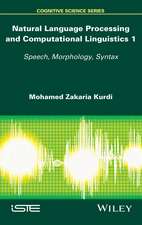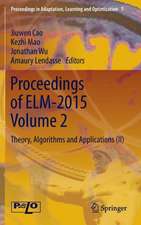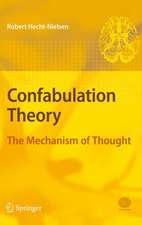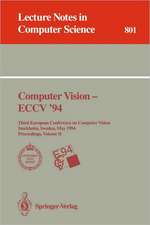Guide to Three Dimensional Structure and Motion Factorization: Advances in Computer Vision and Pattern Recognition
Autor Guanghui Wang, Jonathan Wuen Limba Engleză Paperback – 6 noi 2012
This practical guide/reference provides a comprehensive overview of Euclidean structure and motion recovery, with a specific focus on factorization-based algorithms. The book discusses the latest research in this field, including the extension of the factorization algorithm to recover the structure of non-rigid objects, and presents some new algorithms developed by the authors. Readers require no significant knowledge of computer vision, although some background on projective geometry and matrix computation would be beneficial.
Topics and features: presents the first systematic study of structure and motion recovery of both rigid and non-rigid objects from images sequences; discusses in depth the theory, techniques, and applications of rigid and non-rigid factorization methods in three dimensional computer vision; examines numerous factorization algorithms, covering affine, perspective and quasi-perspective projection models; provides appendices describing the mathematical principles behind projective geometry, matrix decomposition, least squares, and nonlinear estimation techniques; includes chapter-ending review questions, and a glossary of terms used in the book.
This unique text offers practical guidance in real applications and implementations of 3D modeling systems for practitioners incomputer vision and pattern recognition, as well as serving as an invaluable source of new algorithms and methodologies for structure and motion recovery for graduate students and researchers.
| Toate formatele și edițiile | Preț | Express |
|---|---|---|
| Paperback (1) | 921.63 lei 43-57 zile | |
| SPRINGER LONDON – 6 noi 2012 | 921.63 lei 43-57 zile | |
| Hardback (1) | 647.61 lei 43-57 zile | |
| SPRINGER LONDON – 20 sep 2010 | 647.61 lei 43-57 zile |
Din seria Advances in Computer Vision and Pattern Recognition
- 20%
 Preț: 998.36 lei
Preț: 998.36 lei - 20%
 Preț: 409.78 lei
Preț: 409.78 lei - 20%
 Preț: 654.70 lei
Preț: 654.70 lei - 20%
 Preț: 775.30 lei
Preț: 775.30 lei - 20%
 Preț: 867.13 lei
Preț: 867.13 lei - 20%
 Preț: 241.87 lei
Preț: 241.87 lei - 20%
 Preț: 659.83 lei
Preț: 659.83 lei - 20%
 Preț: 1084.17 lei
Preț: 1084.17 lei - 20%
 Preț: 328.60 lei
Preț: 328.60 lei - 20%
 Preț: 650.08 lei
Preț: 650.08 lei - 20%
 Preț: 644.66 lei
Preț: 644.66 lei - 20%
 Preț: 652.54 lei
Preț: 652.54 lei - 20%
 Preț: 646.80 lei
Preț: 646.80 lei - 20%
 Preț: 993.60 lei
Preț: 993.60 lei - 20%
 Preț: 1174.92 lei
Preț: 1174.92 lei - 20%
 Preț: 646.80 lei
Preț: 646.80 lei - 20%
 Preț: 672.36 lei
Preț: 672.36 lei - 20%
 Preț: 1166.52 lei
Preț: 1166.52 lei - 20%
 Preț: 920.33 lei
Preț: 920.33 lei - 20%
 Preț: 825.78 lei
Preț: 825.78 lei - 20%
 Preț: 666.58 lei
Preț: 666.58 lei - 18%
 Preț: 953.65 lei
Preț: 953.65 lei - 20%
 Preț: 999.35 lei
Preț: 999.35 lei - 20%
 Preț: 655.02 lei
Preț: 655.02 lei - 20%
 Preț: 595.16 lei
Preț: 595.16 lei - 20%
 Preț: 647.61 lei
Preț: 647.61 lei - 20%
 Preț: 658.33 lei
Preț: 658.33 lei - 20%
 Preț: 1649.61 lei
Preț: 1649.61 lei - 20%
 Preț: 991.46 lei
Preț: 991.46 lei - 20%
 Preț: 994.08 lei
Preț: 994.08 lei - 20%
 Preț: 1062.57 lei
Preț: 1062.57 lei - 20%
 Preț: 985.16 lei
Preț: 985.16 lei - 20%
 Preț: 640.35 lei
Preț: 640.35 lei - 20%
 Preț: 656.03 lei
Preț: 656.03 lei - 18%
 Preț: 950.52 lei
Preț: 950.52 lei - 20%
 Preț: 652.41 lei
Preț: 652.41 lei - 20%
 Preț: 644.81 lei
Preț: 644.81 lei - 20%
 Preț: 996.40 lei
Preț: 996.40 lei
Preț: 921.63 lei
Preț vechi: 1152.04 lei
-20% Nou
Puncte Express: 1382
Preț estimativ în valută:
176.35€ • 184.62$ • 145.92£
176.35€ • 184.62$ • 145.92£
Carte tipărită la comandă
Livrare economică 07-21 aprilie
Preluare comenzi: 021 569.72.76
Specificații
ISBN-13: 9781447125877
ISBN-10: 1447125878
Pagini: 228
Ilustrații: XIV, 214 p.
Dimensiuni: 155 x 235 x 15 mm
Greutate: 0.34 kg
Ediția:2011
Editura: SPRINGER LONDON
Colecția Springer
Seria Advances in Computer Vision and Pattern Recognition
Locul publicării:London, United Kingdom
ISBN-10: 1447125878
Pagini: 228
Ilustrații: XIV, 214 p.
Dimensiuni: 155 x 235 x 15 mm
Greutate: 0.34 kg
Ediția:2011
Editura: SPRINGER LONDON
Colecția Springer
Seria Advances in Computer Vision and Pattern Recognition
Locul publicării:London, United Kingdom
Public țintă
Professional/practitionerCuprins
Introduction to 3D Computer Vision.- Simplified Camera Projection Models.- Geometrical Properties of Quasi-Perspective Projection.- Introduction to Structure and Motion Factorization.- Perspective 3D Reconstruction of Rigid Objects.- Perspective 3D Reconstruction of Nonrigid Objects.- Rotation Constrained Power Factorization.- Stratified Euclidean Reconstruction.- Quasi-Perspective Factorization.
Textul de pe ultima copertă
The problem of structure and motion recovery from image sequences is an important theme in computer vision. Considerable progress has been made in this field during the past two decades, resulting in successful applications in robot navigation, augmented reality, industrial inspection, medical image analysis, and digital entertainment, among other areas. However, many of these methods work only for rigid objects and static scenes. The study of non-rigid structure from motion is not only of academic significance, but also has important practical applications in real-world, nonrigid or dynamic scenarios, such as human facial expressions and moving vehicles.
This practical guide/reference provides a comprehensive overview of Euclidean structure and motion recovery, with a specific focus on factorization-based algorithms. The book discusses the latest research in this field, including the extension of the factorization algorithm to recover the structure of non-rigid objects, and presents some new algorithms developed by the authors. Readers require no significant knowledge of computer vision, although some background on projective geometry and matrix computation would be beneficial.
Topics and features:
Dr. Guanghui Wang is a Research Fellow at the Department of Systems Design Engineering at the University of Waterloo, Ontario, Canada.
Dr. Jonathan Wu is Professor of Automotive Sensors and Sensing Systems at the Department of Electrical and Computer Engineering at the University of Windsor, Ontario, Canada.
This practical guide/reference provides a comprehensive overview of Euclidean structure and motion recovery, with a specific focus on factorization-based algorithms. The book discusses the latest research in this field, including the extension of the factorization algorithm to recover the structure of non-rigid objects, and presents some new algorithms developed by the authors. Readers require no significant knowledge of computer vision, although some background on projective geometry and matrix computation would be beneficial.
Topics and features:
- Presents the first systematic study of structure and motion recovery of both rigid and non-rigid objects from images sequences
- Discusses in depth the theory, techniques, and applications of rigid and non-rigid factorization methods in three dimensional computer vision
- Examines numerous factorization algorithms, covering affine, perspective and quasi-perspective projection models
- Provides appendices describing the mathematical principles behind projective geometry, matrix decomposition, least squares, and nonlinear estimation techniques
- Includes chapter-ending review questions, and a glossary of terms used in the book
Dr. Guanghui Wang is a Research Fellow at the Department of Systems Design Engineering at the University of Waterloo, Ontario, Canada.
Dr. Jonathan Wu is Professor of Automotive Sensors and Sensing Systems at the Department of Electrical and Computer Engineering at the University of Windsor, Ontario, Canada.
Caracteristici
Presents the first systematic study of structure and motion recovery of both rigid and non-rigid objects from images sequences Provides appendices describing the mathematical principles behind projective geometry, matrix decomposition, least squares, and nonlinear estimation techniques Includes chapter-ending review questions, and a glossary of terms used in the book Includes supplementary material: sn.pub/extras

























